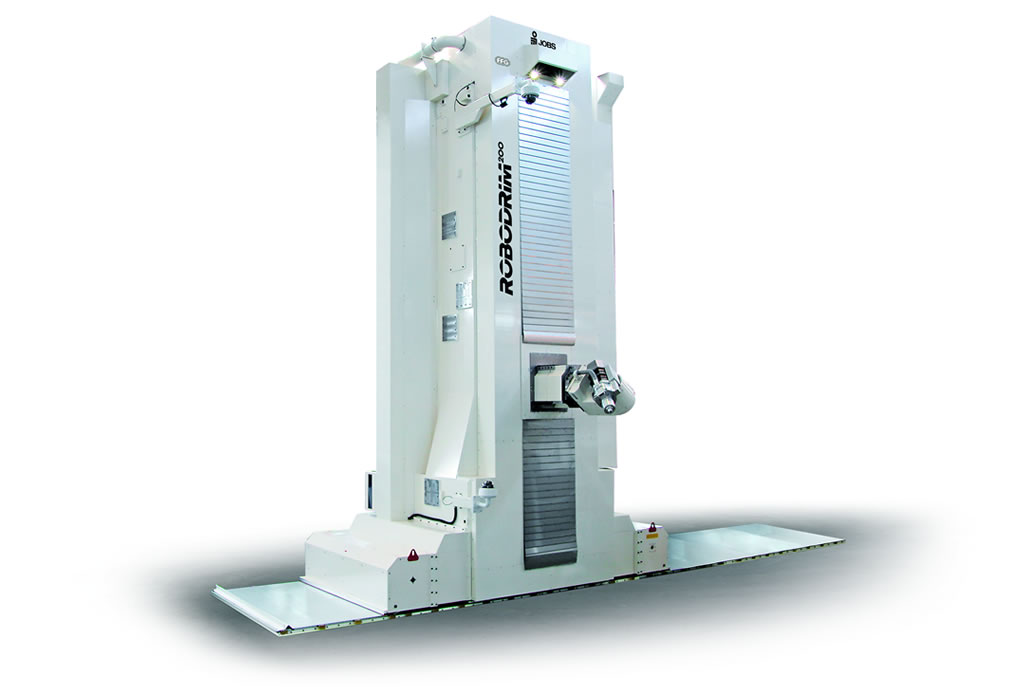

In the field of aeronautical assemblies and, especially, in the machining of pre-assembled subgroups, the technical needs related to these applications are changing. Furthermore, this evolution is driving a significant improvement of the machines dedicated to this purpose.
A key factor in this development is the fact that the subgroups to be machined present a significant range of variables, that differ from piece to piece, but require tighter machining accuracy with respect to values of the variables. For this reason, the machine should not just have the technical capability of manufacturing but should also be able to measure these variables in order to introduce automatic corrections to the machining program if necessary.
As for management system, this type of machine tool is resembling ever more to a robot, specifically in regard to its sensory and process-feedback capacity.
ROBODRIM 200 represents a significant example of this kind of production. It is a machine built by Jobs starting from the structure of the Thor machines family: mobile columns, of different size and power, equipped with a cutting-edge sensor-system.
ROBODRIM 200 is a drilling and milling robot with Cartesian coordinates, to which a 2 or 3 polar axes machining or/and handling terminal can be applied. Jobs developed ROBODRIM thanks to its long experience in the industry and to the most up-to-date design computer-aided systems.
ROBODRIM can be equipped with a series of significant sensor-systems, including:
- dimensional detection systems consisting in probes of several types and laser trackers with the ability of reconstructing the geometry of the workpiece;
- recognition systems of shape variables, such as vision systems and digital image analysis systems;
- management systems of the material stack machining, with automatic material recognition and automatic machining parameters adaptation. These systems must also be able to detect tool’s wear/breakage with retroactive management of twin tools, available in the tool magazine;
- process control systems, such as measurement systems capable of detecting the perpendicular line of the hole, the cylindrical shape of the hole and the depth of the countersink if present;
- data collection systems that allow the complete traceability of all the working parameters of each operation for documentary and maintenance reasons;
- maintenance management systems of the plant with maximum capacity of automatic intervention and with the possibility to connect to remote systems capable of managing the entire plant.
In the specific case, Jobs ROBODRIM is a high productivity machine configured for the execution of large aircraft components machining, such as wing panels and other aircraft components made of composite, titanium, and aluminum.
Characteristics and potentialities
The system is equipped with a T2D-04 milling head, which also allows machining in areas with obstacles or reduced access. The air-blow inside the spindle is dedicated to cool the tip that is in contact with the carbon fiber and titanium-aluminum parts.
ROBODRIM 200 is equipped with a digital probe which can take measurements and, consequently, calculate rototranslations of the aeronautical piece or its parts. This allows drilling and countersinking operations keeping the perpendicularity to the workpiece surface, even if it is not positioned exactly in accordance with the theoretical mathematical model.
Jobs has developed special drilling cycles which allow different combinations of thickness in the drilling and countersinking of the material sandwich (carbon, aluminum, titanium in various sequences). These special cycles do not only verify tools’ wear/breakage, but also are integrated with in-process automatic recognition systems of the materials change.
Following the detection of material changing, which occurs in a continuously variable position, ROBODRIM automatically adjusts the cutting data with the correct technological parameters for the execution of the holes on different materials.
The monitoring of tools’ wear/breakage prevents damaging the part and automatically replaces tools with twin tools available in the tool magazine on board of the machine.
The system is equipped with a dust and chips suction system by means of pressure hoods specifically conceived, which, through a linear measuring system, allow for countersinking operations at an exact depth regardless of the curvature and rigidity of the part to be machined.
Furthermore, the adjustment depth of the countersinking and the pressing force of the hoods on the workpiece can be adjusted in-process by an NC-function. An option for automatic hood changing system that works together with the selected tools is also available.
Finally, the laser system measures and automatically verifies the length and the radius of the tools.
ROBODRIM constitutes a major evolution for machine tools in assembly applications. The design philosophy and construction method are in line with the paradigms of Industry 4.0, which Jobs is progressively introducing into its own products.


